|
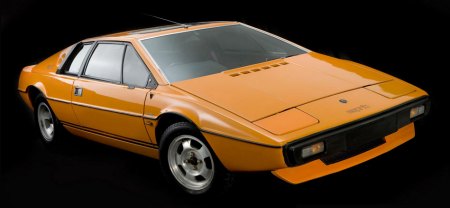
Apart
from the original Porsche 911, I think no other sports cars deserved
the title "evergreen sports car" as well as Lotus Esprit. Production of
Esprit ran from 1976 to 2004, lasted for an incredible 28 years.
Moreover, it rarely showed its age as continuous development kept it
updated and competitive. Apart from long life, Esprit was also the most
significant Lotus because it lifted the British company to the same
league of
Ferrari and Porsche, washing away its previous kit-car image.
Having experimented mid-engined technology with Europa, Colin Chapman
determined to take a more ambitious approach. The target was clearly to
build a rival to Porsche 911 and Ferrari Dino, but it should beat both
in handling and at the same time deliver a stunning message in the same
way as contemporary supercars like Lamborghini Countach, Maserati Bora
or De Tomaso Pantera. To achieve the latter goal, Giorgetto Giugiaro
was called to submit a proposal. The on-form Italian design maestro did
not disappoint Chapman. He created a sensational design that combined
Countach-style wedge profile with simple lines and perfect proportion.
It looked every bit like a supercar.
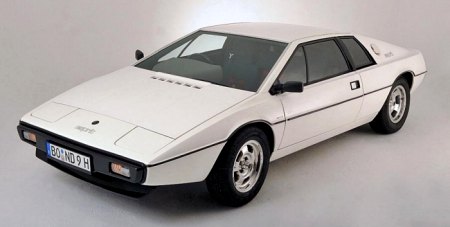 Esprit S1
Esprit S1
Unfortunately, the supercar look was not backed up by the
engine. Lotus originally planned to offer two engines, i.e. an
entry-level
straight-four and a flagship V8. However, due to financial reasons the
V8 did not materialize (until 20 years later), leaving the sole
powerplant to be the four-pot engine. The 1973cc unit, designed and
built by Lotus itself, was truly state of the art. It had all-alloy
construction, twin-cam and 4 valves per cylinder to produce some 160
horsepower, remarkable for its size. Nevertheless, compared with the
3-liter V8 or six-cylinder engines of Ferrari 308GTB (255hp),
Lamborghini Urraco P300 (265hp) and Porsche 911
Carrera 3.0 (200hp), it was way less powerful, let alone De Tomaso
Pantera with its 350hp
American V8. The four-cylinder engine would be the achilles' heel of
Esprit for many more years.
But two things saved the game. First, the Esprit weighed less than 1
ton. Colin Chapman's trademark backbone chassis and glass-fiber body
shell, as well as the small engine helped the car undercutting its
rivals by 200-300 kg. This mean Esprit was pretty accelerative until
its lightweight advantage gave way to aerodynamic drag at higher speed.
With a 0-60 mph
time ranging from 7.5 to the low 8-seconds range, it still failed to
match its more powerful rivals, so it took the second thing to save the
game - a lower price tag. The original Esprit was priced at
£8,000, £2,000 to £5,000 less than its rivals. This
justified for its performance loss.
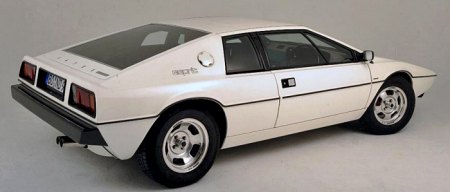 Esprit S1
Esprit S1
Like all other Lotuses, Esprit had first class handling
thanks to its lightweight and excellent chassis balance. Its chassis
was wide and low built. Its lightweight engine was mounted
longitudinally behind the cockpit and in front of the 5-speed transaxle
(which came from Citroen SM). To lower center of gravity, the engine
inclined
to the left by 45 degrees. It was mounted on a tubular rear subframe
together with the rear suspensions which consisted of semi-trailing
arms and lower transverse links. Up front, double wishbones provided
optimum wheel control. Relatively soft springs brought excellent ride
in the tradition of Lotus. Traction, roadholding and braking were all
superb. The unassisted steering was quick and precise, if not as
sensitive as Elan's. The same went for handling, which induced more
understeer than previous Lotuses. In return, you get a more forgiving
behaviour at the limit.
Esprit was not very good at being an everyday transport. Its lowness
implied a relatively cramped cabin and its floor-mounted seats were
difficult to get into. Its fast angle windscreen might look spectacular
outside, but it also resulted in poor visibility and serious light
reflection. On the run, refinement was hampered by excessive wind noise
and engine boom. Luggage space was in short supply as the front was
occupied by the spare wheel, leaving a small boot behind the engine.
Moreover, Lotus' build quality was some way behind its German and
Italian rivals. Many of these flaws would never be sorted out. Like
many supercars of the 1970s and early 1980s, Lotus Esprit was not easy
to live with.
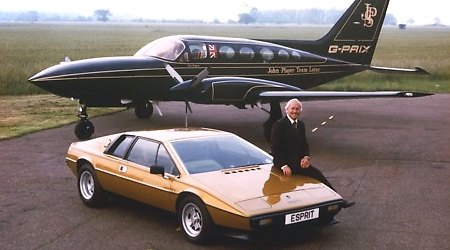
The original Esprit Series 1
(S1) lasted for only 2 years. In 1978, it
was refined to S2. Modifications majored on improving aerodynamics and
engine cooling, which could be seen from its wraparound air dam up
front and the air intakes behind the side windows respectively.
Coefficient of drag was reduced from 0.376 to 0.36. Other modifications
included new instruments, seats, alloy wheels and taillights. As the
engine remained unchanged and the refinement gained weight, S2 was
actually slightly slower than S1.
Series 3
and Esprit Turbo (1981)
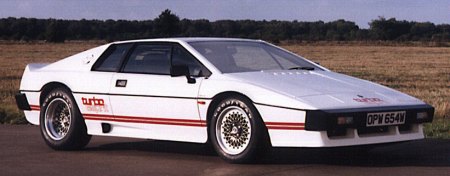
In the last model year of Series
2 (1980), Lotus introduced significant
changes to its engines. The 1973 cc engine was enlarged to 2174 cc.
Peak power remained unchanged at 160hp, but maximum torque increased
from 140 to 160 lb-ft and this improved its acceleration a little.
Meanwhile, a
special edition called Essex Turbo introduced turbocharging to the
Esprit, lifting output to 210hp and 200 lb-ft.
Next year, the 2.2-liter naturally aspirated engine and 2.2-liter
turbocharged engine became standard on the Series 3 cars. Externally,
S3 was a big departure from S2. It had aggressive aerodynamic kits all
round to remind us the golden years of 1980s (the "Turbo Esprit"
graphics also helped). Larger 15-inch alloy wheels replaced the
original 14-inch items, and the rear ones were wrapped with much wider
(235 vs 205mm) rubbers to enhance grip. Underneath the skin, the
chassis was fully galvanized to resist rust, the rear suspensions were
strengthened to cope with increased power and the engine mount was
upgraded to reduce NVH.
The turbocharged engine finally gave Esprit the performance, if not
image, it needed
to compete with Ferrari and Porsche. It was capable of accelerating
from 0-60 mph
in less than 6 seconds and to 100 mph within 16 seconds, quicker than
Ferrari 308GTB and Porsche 911SC. Top speed hit 152 mph when Lotus
tested the car at Nardo high-speed test track in Italy. Its inflated
price also reflected this
improvement.
Unlike contemporary
turbocharged cars, Esprit Turbo had a good driving
manner. It produced plenty of bottom-end torque and its power delivery
was
progressive, allowing the driver to exploit its superb handling and
ride. In terms of image or aural excitement, the four-cylinder turbo
engine was no match with rivals' V8 or 6-cylinder boxer, of course.
However, its new found performance and superior chassis were already
sufficient for British motoring press to declare it a class winner.
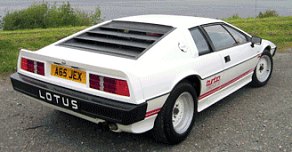 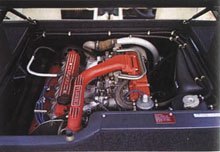
The short-lived HC Turbo
was introduced at the last model
year of S3. HC stands for High Compression, which implied the
turbocharged engine's compression ratio was lifted from 7.5:1 to 8.0:1.
Other improvements to the engine included forged aluminum pistons,
Nikasil cylinder liner, revised camshafts and valves and a smaller yet
higher boosting Garrett T3 turbocharger. These mods boosted 5
horsepower and 20 lb-ft of torque, leading to slightly improved
performance and better drivability. Otherwise the car was almost
identical to previous Esprit Turbo.
Esprit
X180 (1987)
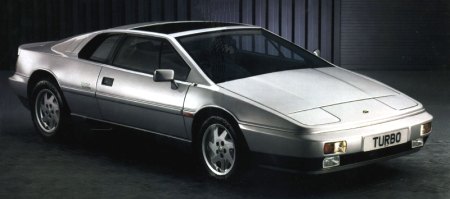
11 years had passed
since its birth, Esprit received its biggest revamp in 1987. Strangely,
the new version did not use the S4 label. It was simply called Esprit
or Esprit Turbo. In order to distinguish it from previous versions,
insiders referred to its project code, X180.
X180 was designed
in-house by Peter Stevens, who would go on to style
Elan M100, Jaguar XJR-15 and McLaren F1. While it retained the hard
points and general proportion of the original Giugiaro design, it was
made rounder, smoother and thoroughly modern. To me, it was easily the
best looking Esprit of all, and one of the best looking sports cars of
its time. The new clothes not only lowered aerodynamic drag to 0.335,
but it also appeared high quality and tight fit, thanks to a new
glass-fiber molding process called VARI (vacuum-assisted resin
injection). VARI resulted in tight tolerances and even thickness. In
addition to some Kevlar inserts at roof and pillars, the new body shell
contributed to higher chassis rigidity, hence better handling and
higher refinement.
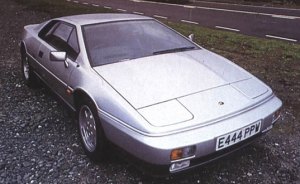 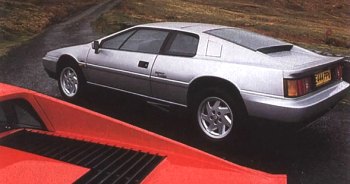
Mechanically, the X180 did
not differ a lot from the previous HC. Its 2.2 turbocharged engine
produced the same 215hp and 220 lb-ft despite of a more durable
water-cooled turbocharger (but still without intercooler). A naturally
aspirated version with 173hp continued to be offered alongside the
turbo, although it was a less popular choice. The biggest
change was found at the transaxle gearbox, which was sourced from the
new Renault Alpine GTA. This brought
improved shift
quality as well as a slightly taller gearing. The Renault transaxle
gave no place for the previous in-board rear brakes, so the X180
switched to
conventional out-board disc brakes. Other improvements majored on
reducing noise level and improving cabin comfort. The cabin got a
welcomed 20 mm
extra headroom, 15 mm more legroom and a 25 mm wider foot well.
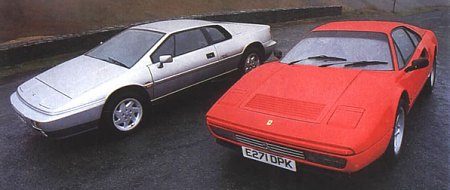 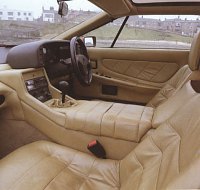 Theoretically, the
heavier X180 should be slower than previous one.
However, the revised gearing actually benefited 0-60 mph sprint,
whereas acceleration at higher speed was benefited from the reduced
drag. As a result, it was actually faster than the old car. Autocar
magazine found it capable of a true 150 mph top speed, accelerate from
rest to 60 and 100 mph in 5.4 and 13.3 seconds respectively. This put
it ahead of Ferrari 328GTB and Porsche 911 Carrera 3.2. Best of all,
the £30,000
price it asked was much lower than its rivals. No wonder X180 was a
commercial hit. It set Esprit's highest sales record in 1988, with more
than 1,000 cars leaving the Hethel factory. This would never be matched
again.
Esprit Turbo SE (1989)
Theoretically, the
heavier X180 should be slower than previous one.
However, the revised gearing actually benefited 0-60 mph sprint,
whereas acceleration at higher speed was benefited from the reduced
drag. As a result, it was actually faster than the old car. Autocar
magazine found it capable of a true 150 mph top speed, accelerate from
rest to 60 and 100 mph in 5.4 and 13.3 seconds respectively. This put
it ahead of Ferrari 328GTB and Porsche 911 Carrera 3.2. Best of all,
the £30,000
price it asked was much lower than its rivals. No wonder X180 was a
commercial hit. It set Esprit's highest sales record in 1988, with more
than 1,000 cars leaving the Hethel factory. This would never be matched
again.
Esprit Turbo SE (1989)
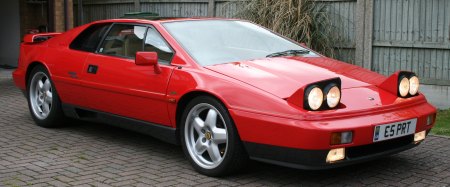
In 1989, Lotus introduced
Esprit Turbo SE as the flagship model of the Esprit range which until
then comprised of 215hp Esprit Turbo and 173hp Esprit. At £42,500,
the SE was really
expensive - £12,000
more than the regular Turbo. However, this premium also lifted its
performance to another level. Thanks to an air-to-liquid intercooler
that Lotus called "Chargecooler", its engine got supply of cooler,
denser air from the Garrett TB03 turbo. The result was 264 horsepower,
163 mph top speed and 0-60 mph in 4.7 seconds. Externally, the SE
distinguished from lesser models by a rear spoiler, larger wheels and
wider tires. Inside, fully leather trimmed cabin and walnut dashboard
tried to bring a classier image. However, at this
price level the uninspiring noise of the four-cylinder engine became
increasingly difficult to justify, even though handling and ride was
still
world-class.
Esprit Sport 300 (1993)
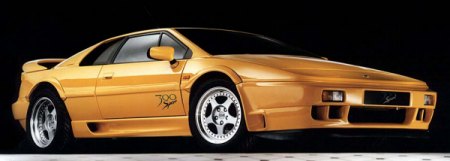
In pure driving terms, no other Esprits could match Sport
300. Lotus launched the Sport 300 in 1993 as a limited production run
of 50 cars. It was practically the road-going version of X180R race car
that had just won America's SCCA championship, no wonder it had the
sharpest handling of all Esprits. The Sport 300 was 80kg lighter than
contemporary Esprit S4 thanks to a lighter composite bodywork and a
striped-out cabin. The latter sacrificed air-conditioning, audio system
and much of the sound insulation, replaced leather trim with alcantara
and employed lightweight racing bucket seats. Meanwhile, the backbone
chassis was strengthened in various places, including extra bracings in
engine compartment.
The engine was again the familiar 2.2-liter Chargecooler turbo, but a
revised turbocharger, hand-polished intake ports, larger inlet valves
and recalibrated engine management system squeezed out a record 302
horsepower. On the down side, the power delivery became peakier,
demanding 3500 rpm to get into the power band. Use the power band
wisely, the Sport
300 could be incredibly quick. Its top speed approached 170 mph and its
0-60 mph was claimed to take only 4.6 seconds.
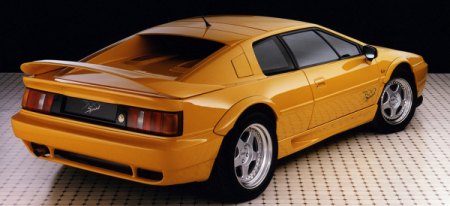
Straight line performance did not take S300 to the peak of the Esprit
history. Instead, it was its handling. The combination of its
lightweight treatment, stiffer chassis, reworked suspensions (with
stiffer springs, dampers, bushings and revised geometry) and much wider
rubbers (245/45Z16
front and 315/35ZR17 rear, which necessitated those wheel arche
extensions)
resulted in the best handling among all Esprits. It was praised for
tremendous roadholding, rock-steady body control, accurate steering and
progressive power slide at the limit. Above all, its sharp
turn-in and extraordinary sense of agility set it apart from other
road-going Esprits.
Its weaknesses? Harder ride, poor rear visibility (due to the large
rear spoiler), noisy, engine boom at 100 mph,
uninspiring 4-cylinder sound and a price tag some 40 percent higher
than the regular S4.
Esprit S4 (1993) and S4S (1995)
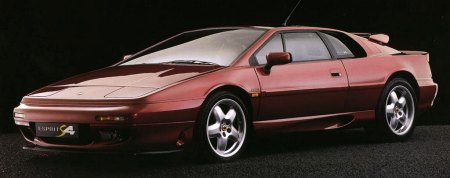
Entering 1990s, the X180 generation Esprit turbo and SE
started losing momentum as newer rivals emerged, e.g. Porsche 964
Carrera / Turbo,
Ferrari 348tb and Honda NSX. Sales declined to the level of 300 cars
per year and it would never quite recover. In 1993, both cars were
replaced by a single model, S4.
The S4 introduced a facelift by Julian Thompson. Its new bumper and
side skirts incorporated some rakish intakes as an attempt to follow
contemporary stylng trend, although whether it looked prettier than the
Peter Stevens design is questionable. The rear spoiler was moved higher
above the flying buttresses to take advantage of air flow. The larger,
17-inch alloy wheels and low profile tires look more modern.
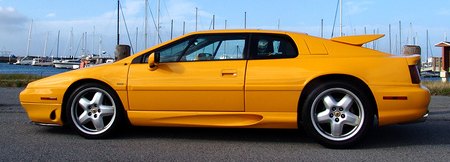 S4 S4
Engine remained unchanged from the SE, so did its performance. However,
the chassis was fine tuned
with revised suspension geometry, a generally stiffer setup and the
first ever power steering system on Esprit. This reduced understeer and
sharpened chassis response a little. On the downside, its ride quality
was no longer exceptional.
In 1995, the car evolved again to S4S. This time its engine and chassis
were benefited from various modifications found on the Sport 300. The
2.2 turbo engine was practically the same as S300's, with the exception
of using a smaller turbocharger to improve low-end response. As a
result, its power band began from 2500 rpm instead of 3500 rpm, greatly
enhancing tractability. The trade-off was a slightly lower peak power
at 285 hp.
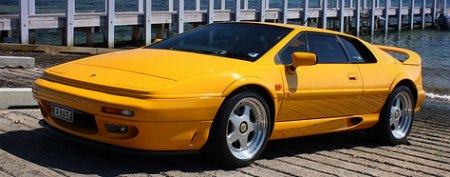 S4S S4S
Being a production car, the S4S was not benefited from the weight
saving measures of Sport 300, but it did employ the latter's extra
bracings in engine compartment to increase chassis rigidity. The
suspension tuning was closer to S300 than S4, with stiffer springs and
slightly softer dampers. Wheels and tires were enlarged again.
Externally, S4S differed from S4 by reverting to the tail-mounted rear
spoiler of S300.
S4S remained arguably the best handling high-end sports car on the
market, even compared against the very best Ferrari F355 and Porsche
993. It had the best steering, the best balance and the best body
control among its rivals. At the limit, its handling was amazingly
friendly, responding to your abuse with progressive oversteering.
However, the achilles'
heel was again the outdated powertrain. The four-pot engine remained
coarse and ugly sounding at rev. The Renault 5-speeder did not help
with its wide ratios and slow gearchange. This explain why the Esprit
often came lowly in comparision tests.
Esprit V8 (1996)
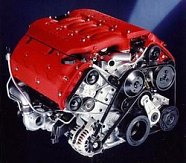 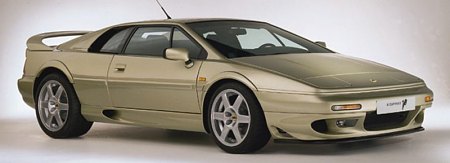
Externally, the 1996 Esprit looked almost identical to
last year's S4S. However, the biggest news lay under the engine lid - a
twin-turbo V8 ! After exactly 20 years, Esprit finally realized the V8
it originally planned ! It was the result of a £5.5 million
investment. Obviously, Lotus wanted to sell this engine also to other
car makers. Eventually, however, only a handful engines were sold to AC
for the still-born ACe and small-scale production Cobra 212S/C. The
majority went to the Esprit.
The 3506cc twin-turbo 32-valve V8 was renowned for compact size and
lightweight. With all-alloy construction, it added only 50 kg to the
car. It was also shorter than the outgoing 2.2-liter turbo, so it
actually freed up space for the luggage compartment locating behind it.
Theoretically, it was capable of producing more than 500 horsepower.
Unfortunately, the ancient Renault gearbox had a torque capacity of
400Nm (295 lb-ft), so Lotus had to detune the V8 to 350hp and 295
lb-ft. A maximum
boost pressure of just 0.5 bar and the lack of intercooler showed how
easy it got to that state of tune. Sadly, having spent so much money on
the V8, Lotus could not afford a new gearbox.
Still, the V8 Esprit could sprint from rest to 60 in only 4.2 seconds
and 100 mph in just over 10 seconds, putting it ahead of Ferrari F355,
if not Porsche 993 Turbo. Not so good was the subjective feel.
Ridiculously, the V8 had a flat plane crankshaft design (to save
weight) and this made it sing very much like a four-cylinder engine !
Lotus seemed to forget why people always prefer a V8 to a
straight-four. Apart from uninspiring sound, its power delivery was
equally uninspiring. Compare with Porsche Turbo its power was too
linear to the extent of boring, and throttle response was pretty slow
beside a Ferrari V8. Lotus' first V8 was not a memorable one, neither
was the first eight-cylinder Esprit.
Esprit GT3 (1996)
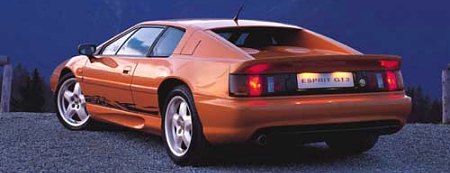
Esprit V8 might be the headline in 1996, but the cheaper GT3
was actually a better driver's car. It was a lightweight special in the
same mold of Porsche's Clubsport. By ditching cabin equipment (sound
deadening, air-con, HiFi, airbags and normal seats) and those emission
/ safety devices for US compliance (as it was not destined to America),
plus reverting to a 2.0-liter four-cylinder turbo engine, the GT3
undercut its V8 sibling by as much as 140 kilograms, lowering its kerb
weight to 1240 kg. The 1973 cc engine was not a development of the
original Esprit engine, of course, but a downsized version of the
chargecooled
2.2 engine originally destined to Italian market (where engines
exceeding 2000cc were taxed heavily). In fact, the GT3 was created to
clear the unsold stocks of the Italian version engine. This explain why
its production stopped after only 196 units were built.
The 2-liter engine produced 240hp and 216 lb-ft, enough to register 160
mph and 0-60 mph in 4.8 seconds. 0-100 mph was equally impressive at
12.5 seconds. Considering the GT3 was sold at £40,000, compared with the
£60,000
V8, it was
quite a performance bargain.
Three things made the GT3 more lovable than the V8: first, it looked
cleaner and prettier than its big brother, thanks to a small rear
spoiler and narrower tires which demanded no bolt-on wheel arch
extensions. Second, its reduced weight resulted in sharper handling and
better balance. Third, its ride was more supple than the stiff-legged
V8. What a pity the car was short lived.
Esprit
Sport 350 (1999)
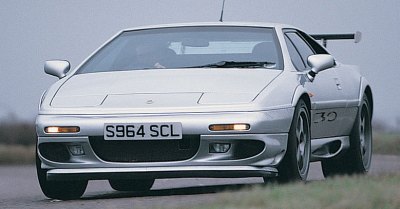
By the time GT3 went
out of production in 1999, V8 became the only Esprit available. This
would remain unchanged until its extinction in 2004.
V8 had three variants, i.e. SE, GT and Sport 350. The first two
differed very little from the standard car. The Sport 350 was the only
one worth mentioning. In terms of performance, it was the ultimate
Esprit. Power came from the same 350hp V8. Chassis was tuned to be
extremely aggressive, with track-oriented stiff suspension setting,
wider rear rubbers, lighter alloy wheels, stronger AP brakes and
striped-out interior. Exterior was distinguishable by a big
carbon-fiber rear spoiler mounted on aluminum brackets. As it carried
80 kg less than the V8, acceleration was superior. On public road,
however, its ride was very hard and noisy. After all, the Sport 350 was
designed primarily for track use.

End of Road
On Feb 20, 2004, the last Esprit V8 finally left the Hethel factory,
ending the 28-year-long history of Esprit. A total of 10,675 Esprits
were built.
|